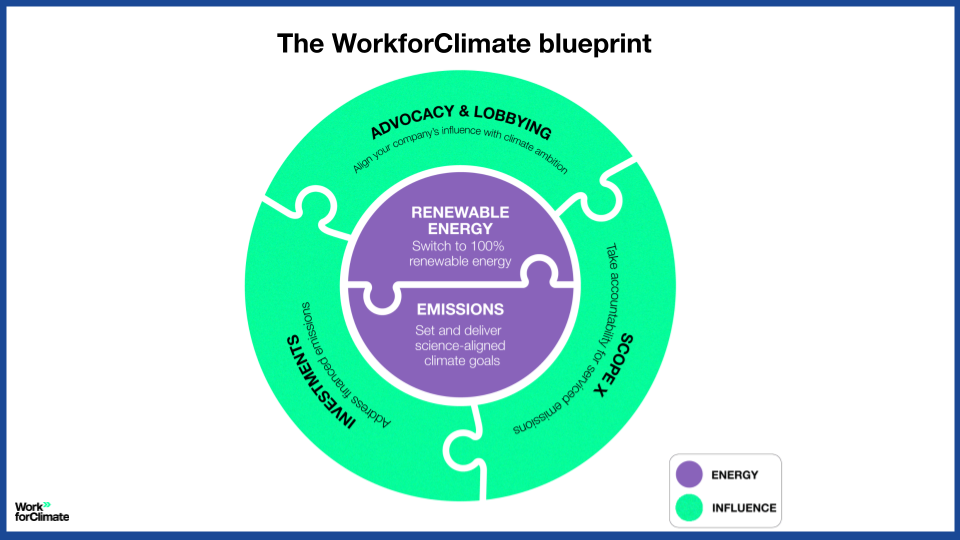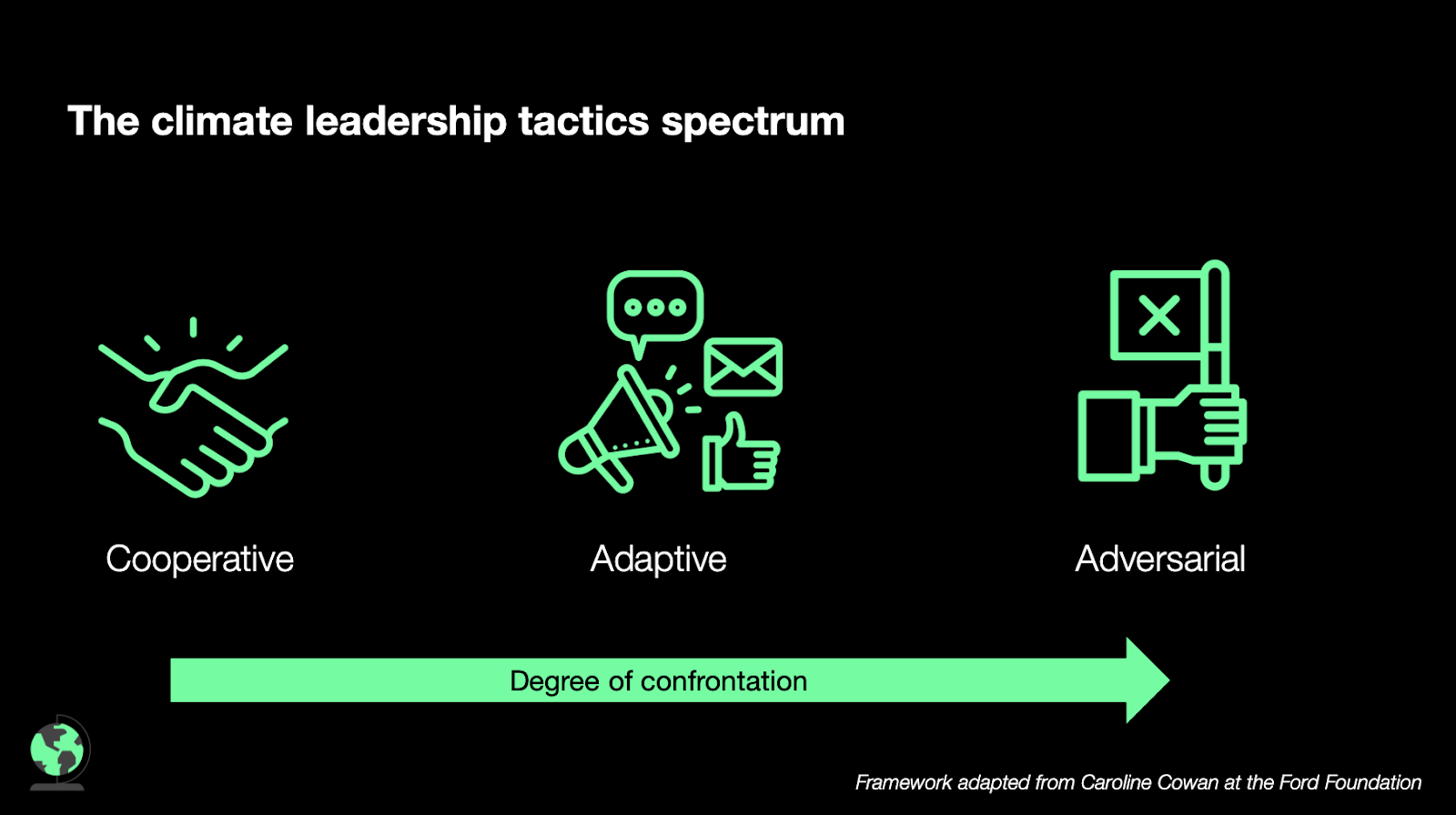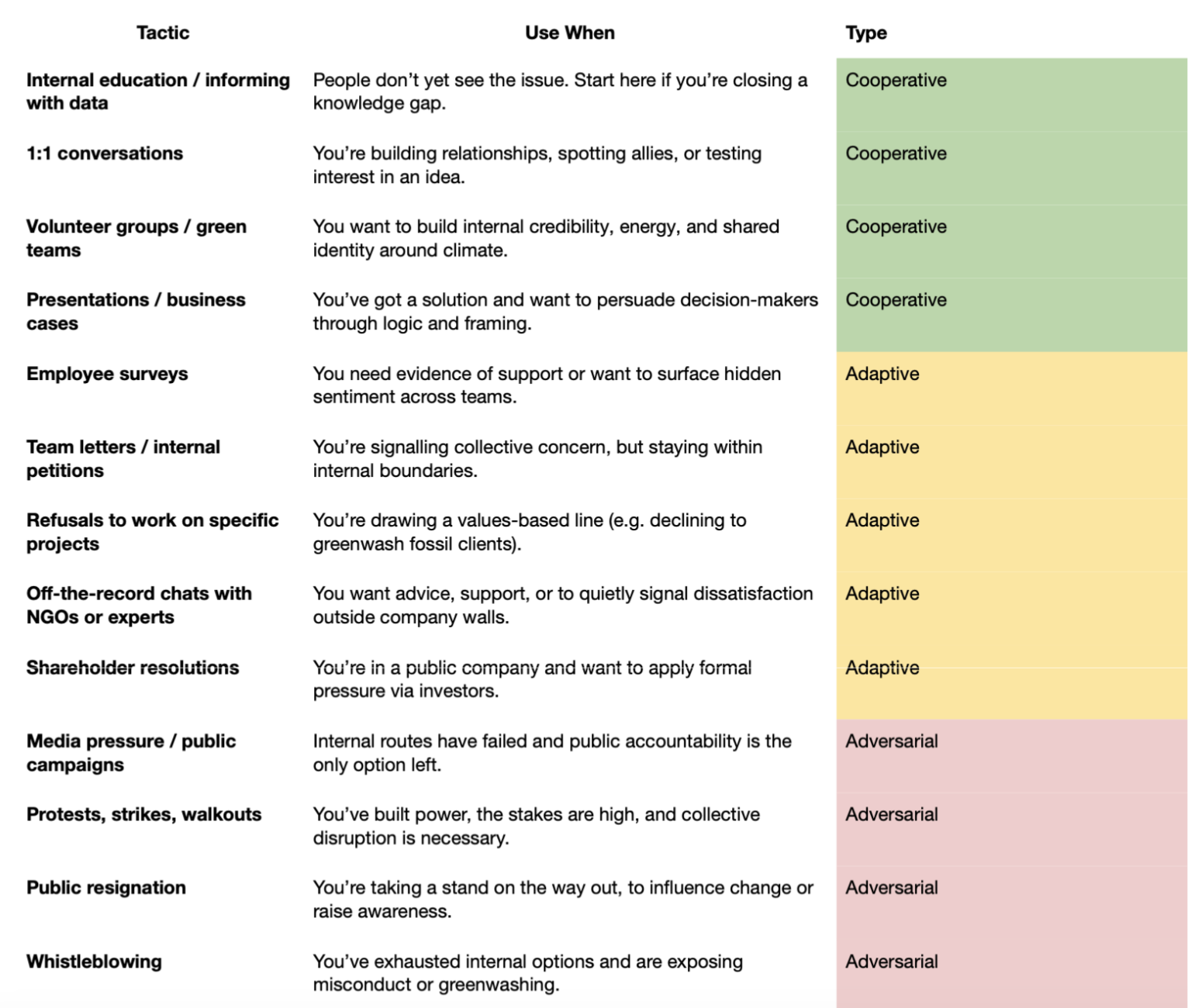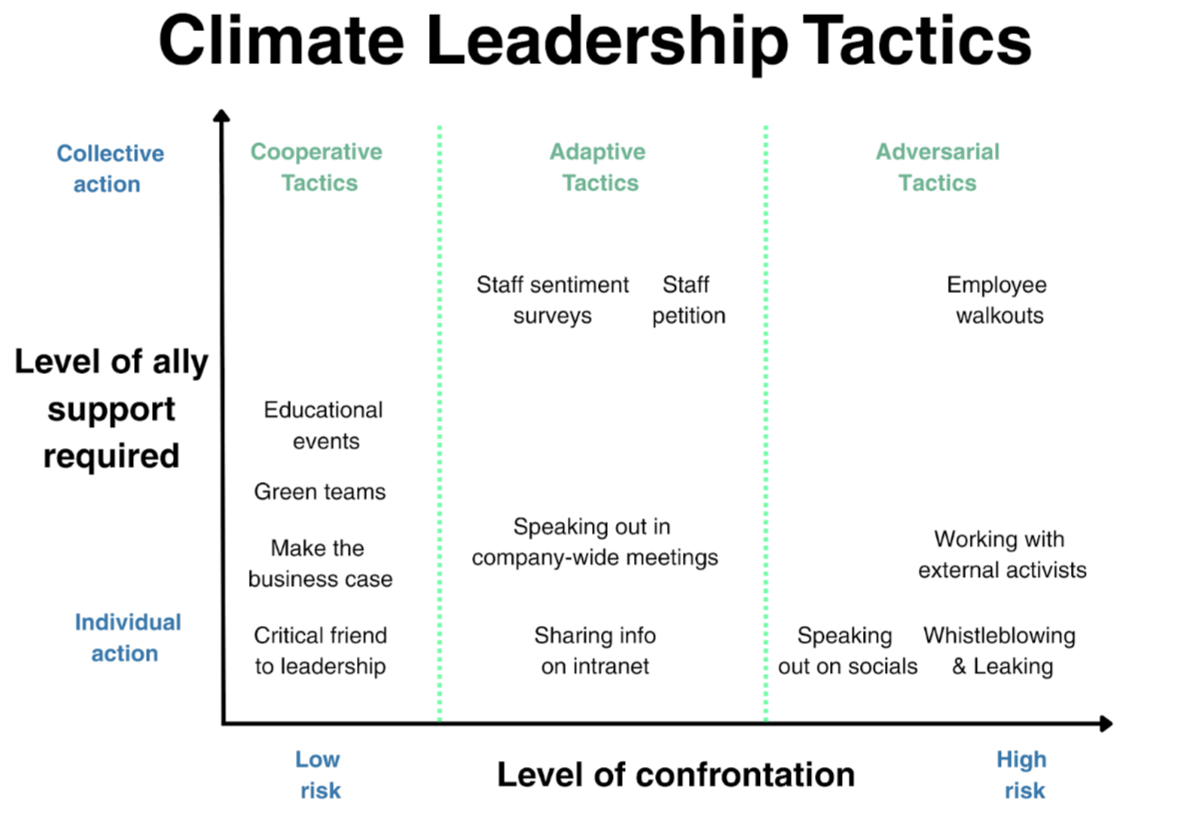1. What this guide will help you to do
Across the world, employees are waking up to their power. They’re realising that climate action isn’t just the job of sustainability teams; rather, it’s something that can (and must) be driven from people in every corner of an organisation. And increasingly, they’re stepping up to challenge greenwashing, push for science-aligned commitments, and ask tougher questions about who the company works and advocates with.
But knowing what needs to change isn’t the same as knowing how to make that change happen. Some employees default to education tactics when leadership already understands the issue but won’t budge. Others jump to public confrontation too soon, risking their influence before they’ve built enough internal support. That’s why one of the most important things any employee climate leader can learn is how to match the right actions to the right moment.
This guide is built around a simple structure:
- Goal: What are you trying to change? (e.g. end a fossil fuel contract, shift pension investments, stop greenwashing)
- Strategy: How will you get there, given your context and constraints? (e.g. build internal support, reframe the issue, escalate pressure, expose contradictions)
- Tactics: What specific actions will deliver that strategy? (e.g. a business case, a petition, a shareholder resolution, a walkout)
We’ll walk through each of these stages step-by-step. Along the way, you’ll explore how to map resistance, choose tactics that match the moment, assess risk, build collective power, and know when (and how) to escalate.
2. Clarify the goal
Before you start planning how to act, you need to get specific about what you’re trying to change. Not just in broad terms (“we want stronger climate action”) but in specifics: what decision, relationship, or policy needs to change? What lever are you pulling, and why does it matter?
To help employees focus their efforts, we developed a framework to help you identify the five shifts that can have the biggest, most science-aligned impact; regardless of industry or company size.
The framework organises goals into two categories: how your company operates, and how it influences the world around it.
🔌 Energy (operational power)
- Transition to 100% renewable energy: The fastest way to reduce emissions and signal seriousness. Every company uses electricity, and how it’s sourced matters.
- Set and deliver science-aligned emissions targets (Scopes 1–3): Most targets are partial, insufficient, rely on carbon offsets, or are unrealistic. The real work here is pushing for full accountability across the value chain of a business, with interim targets and with minimal reliance on offsets.
📣 Influence (strategic power)
- Shift services and client relationships to avoid ‘Scope X’ emissions: If your company helps other businesses grow fossil fuel profits, it’s enabling emissions off the books. Change who you work for, and how.
- Reroute money away from fossil fuels: This includes where your company banks, who manages its pension funds, and which suppliers it relies on. Capital is climate strategy!
- Align lobbying and advocacy with climate science: Companies often say the right thing while quietly lobbying or funding groups that do the opposite. You can help close that gaping credibility hole.

You don’t need to take on all five goals, or start with the hardest one. A good place to begin is by asking: Where is there already energy or interest? What aligns with your role, your influence, or existing conversations inside the company?
If your company is early in its climate journey, you might start with a goal that has a clear business case and lower resistance, like switching to 100% renewable electricity. These kinds of changes can build credibility and momentum for deeper shifts later.
If your company is already making public commitments but avoiding more systemic issues (like lobbying or client relationships) then that may be where your influence is most needed.In short: the best goal is one that’s specific enough to act on, but meaningful enough to matter.
Once you’ve chosen your goal, ask: what kind of resistance am I up against? You can often break this down into three kinds of barriers:
- Knowledge gap: Are the key decision-makers unaware of the issue, the risk, or the opportunity? (They may not know about Scope X emissions, or realise the company has fossil fuel exposure in its pension fund.)
- Power imbalance: Do they know, but feel incentivised to protect the status quo (e.g. because of revenue, clients, political relationships)?
- Values misalignment: Do they fundamentally disagree with the goal, or prioritise other values (e.g. growth, neutrality, shareholder returns)?
These barriers shape what kind of strategy will be effective. In the next chapter, we’ll explore how to choose one that fits your context – and moves the people who need to be moved.
3. Create your strategy
You’ve now clarified your goal, and you’ve hypothesised the kind of resistance you’re likely to face; whether it’s a knowledge gap, a power imbalance, or a values misalignment. Now it’s time to decide how you’ll approach the work of shifting it (i.e. your strategy).
Many employee advocates jump straight from goal to action… But without a strategy, even the best tactics can fall flat. Strategy is what connects your intent to your impact: a deliberate plan for how to build momentum and shift power over time.
What does strategy actually mean in this context?
Your strategy is your theory of change: your hypothesis about how change will happen, and a plan for how you’ll influence decision-makers, shift power, or move the conversation over time. It’s shaped by your company’s culture, who holds influence, and what kinds of stories leadership tends to respond to.
It’s also grounded in research. You need to understand what’s really getting in the way of change, if you’re going to effectively map out a shift. For example, if you're pushing for a fossil-free default pension for employees, you might assume the barrier is apathy. But it could actually be a belief that changing the default fund would breach fiduciary duty. That’s not just a hurdle; it’s an actual rationale and narrative that needs to be unpacked and challenged.
Your strategy, then, should include:
- Gathering counterarguments, examples from other companies, and credible third-party validation
- Mapping decision-makers and understanding what drives them
- Identifying allies, likely blockers, and soft entry points
- Reframing your ask so it lands with the people you need to move
How organisations change: three common pathways
To help clarify your strategic approach, it can be useful to think about how your company might respond. One framework we use categorises organisational change into three broad pathways:
- Conversion: when leadership genuinely shifts its position because of new evidence, strong internal logic, or a sense that it's in the company’s best interest. This is the classic “hearts and minds” strategy - and often effective if the issue is a knowledge gap that can be addressed through education, storytelling, or sharing internal data.
- Accommodation: when leadership makes concessions because they sense the balance of forces is shifting (through collective pressure, employee visibility, or reputational risk). This pathway is often effective when facing a power imbalance, especially when combined with a growing base of support, coordinated asks, or the risk of escalation.
- Coercion: when the cost of maintaining the status quo becomes higher than the cost of changing; often due to public pressure, disruption, or risk to profit or credibility. It tends to be necessary when the barrier is a values misalignment – and can be addressed through organising, reframing the public narrative, or forcing accountability.
You don’t need to know exactly how change will happen from day one. But it helps to make an early call: Are we trying to convince leadership? Pressure them into accommodation? Or raise the cost of inaction? Your tactics will look different depending on the answer.
4. Choosing your tactics
Once you’ve clarified your strategy, you’re ready to choose tactics: the specific, concrete actions that deliver your plan. We frame this as the ‘spectrum of climate leadership tactics’, which breaks them down into three broad categories.

- Cooperative tactics work with the grain of the system. They rely on alignment: making the case internally, winning hearts and minds, and positioning climate action as a business opportunity.
- Adversarial tactics challenge the status quo. They’re about applying pressure, raising stakes, and making inaction uncomfortable.
- Adaptive tactics sit somewhere in the middle. They mix pressure with pragmatism, building momentum while keeping relationships intact.
There’s no perfect sequence, but it helps to map your options. Here’s a list of common employee-led tactics, ordered (roughly) from least to most adversarial:

Remember that different tactics carry different levels of pressure, visibility, and risk. The key is to choose one that fits both the context you’re operating in and the point you’re at in the change process.
Usually that means starting small to test the waters, gather information, and build trust. Other times, the urgency or power dynamics call for something stronger, more public, more disruptive. And don't forget that these tactics aren’t linear steps; they’re options. What matters is choosing the right one for where you are in terms of the issue, the timing, the power you hold, and the level of support around you.
Take the example of Maren Costa and her colleagues at Amazon. They didn’t leap straight to walkouts; rather they began with internal advocacy, built a network, landed some wins (like securing more climate commitments), and gradually escalated. When those wins stalled and leadership pushed back, they had a base of support to draw from – and the credibility to justify more public action.
5. Consider risk appetite
Before you choose a tactic, it’s also important to consider what you (and your allies) are actually willing to risk.
This is because different tactics come with different stakes. Some are low-key and reputationally safe, while others carry career or legal risks; especially if they challenge powerful clients, leaders, or revenue streams. While some can be done solo, others require broad support and shared accountability.
The goal here isn’t to scare you off. It’s to help you act with intention and with long-term change in mind. Because some level of risk is often required to drive outcomes that matter. The tactics that carry more risk are often the ones that carry more power: they provoke a response, signal seriousness, and show that employees are willing to confront the status quo when internal efforts stall.
What kinds of risks are we talking about?
💼 Career risk
Could this affect your promotion prospects? Access to senior leaders? Seat at the table?
🧍 Personal risk
Will this expose you to reputational damage? Mental stress? Isolation within your team?
📄 Legal risk
Are you crossing a line into whistleblowing, contract breach, or internal code violations? How can you legally protect yourself?
🤝 Collective risk
Who else could be affected? Junior staff? Contractors? People on temporary visas or with dependents? Plan ahead by identifying who might be able to take higher risks (e.g. those planning to leave the company), and who may need safer, lower-profile roles. Collective action should make space for everyone’s risk threshold, not just the boldest.
Note: the same tactic will land differently depending on your role, your identity, your internal reputation, and your company’s culture. A senior exec might be applauded for raising concerns, while a junior staffer might be penalised for the same move.
Rule of thumb: If you’re in a relatively secure position, you can absorb more risk – but don’t take action on someone else’s behalf without their consent. As Maren Costa (a successful employee organiser) says, "The level of risk you take should be proportionate to your level of privilege”.
Acknowledge fear, and build safety
Not everyone will feel ready to act, and that’s okay. Fear around risk is real, especially for those in less secure positions. Some employees might be caring for young children or family, working on a visa, or simply unsure whether speaking up will put their role or reputation at risk.
Never minimise someone’s fear, and don’t frame caution as a lack of courage. Instead, share why this work matters to you, how you've navigated fear or doubt, and why collective action (rather than individual heroics) is what creates safety and momentum. You can also invite others to reflect on what the climate crisis means to them, and how change rarely happens without shared risk.
What are some ways that you can lower risk?
- Don’t name names until you have critical mass. (Groups like Amazon Employees for Climate Justice held back names on an online petition until they had strength in numbers)
- Use anonymous tools like surveys, shared docs, and backchannel groups on platforms like Signal to build support before going public.
- Don’t just escalate at leadership. Escalate with your community, so that if there’s pushback, no one stands alone.
And always, always do your research. In some countries, employees have formal representation through Works Councils or collective bargaining structures, while in others, protections exist but can be patchy. Whistleblower laws can similarly vary wildly, depending on where you’re based.
Tip: If you’re considering whistleblowing or breaking company policies, seek legal advice first. Know what you’re stepping into before you step forward. You can also check out our guide on talking to the media as an employee climate advocate.
Remember: collective action is the endgame
Some tactics (like submitting a business case or refusing to greenwash a client) can be taken alone. Others, like a group petition, coordinated work refusal, or a public campaign, rely on collective effort and shared protection.
If you’re just getting started, it’s okay to begin with individual steps. Individual actions can help you test the waters, gauge leadership’s response, and build early momentum, at the same time as help to surface others that may want to be involved in taking action.

But if your goal is meaningful, lasting change (not just surface tweaks) organising as a group is the most effective path.
That means building relationships, naming shared concerns, and acting collectively with colleagues. Because when employees move together, they shift power. They make it harder to ignore the issue (or punish those raising it), and help increase your chances of success. It can also help to lower the risk for individual employees acting.
So yes, start small if you need to – but don’t stop there. Ask yourself how your action today sets the stage for something stronger tomorrow: something shared, strategic, and sustained. Because in the end, the biggest risk isn’t always speaking up. Sometimes, it’s staying silent… At the expense of your colleagues, your values, and the planet.
6. What it can look like in practice
So far, we’ve explored how to define your goal, create a strategy, choose tactics, and weigh the risks. Now, let’s bring that to life with some examples.
The following examples aren’t necessarily “best practices”; there’s no one-size-fits-all in this work. Instead, they’re examples of what good tactic-goal alignment can look like in different situations. In each case, the tactic matched the goal’s complexity, the power dynamics at play, and the risk appetite of the people involved.
Similarly, while some involve escalation, others don’t. In some cases, a simple business case is enough, while in others (especially where power or values are in tension), pressure needs to build.
Example 1: Advocating for 100% Renewable Energy
Goal: Shift the company’s electricity supply to renewables
Strategy: Frame the switch as a business win and use internal persuasion to secure buy-in
Tactic: Internal business case and exec ally support
Barrier: Knowledge gap + perceived cost concerns
Type: Cooperative
An employee might notice that their company is still using grid electricity despite strong climate commitments. They could put together a simple internal briefing outlining supplier options, potential savings, and reputational benefits. Rather than going wide, they might start by testing the idea with a trusted executive sponsor, then raise it more formally during planning discussions. If the ask is low-conflict and financially sound, there may be no need for pressure; just clarity and good timing.
Example: see how Bernie Wiley helped advocate for a switch to 100% renewable energy, starting with rooftop solar.
Example 2: Ending work with a fossil fuel client
Goal: Remove a fossil fuel client from the company’s portfolio
Strategy: Use collective refusal and internal pressure to shift decision-makers from resistance to accommodation
Tactic: Team-level refusal to work + collective letter
Barrier: Values misalignment + power imbalance
Type: Adaptive → Adversarial
At a professional services firm, employees might begin raising quiet concerns about a major fossil fuel client. If those concerns aren’t taken seriously, the team could coordinate privately, agree not to work on the account, and follow up with a collective internal letter outlining their reasoning. They might also propose a set of ethical client criteria or a screening framework. The refusal could create reputational risk and internal pressure, helping open up conversations that were previously off-limits.
Example 3: Changing lobbying practices
Goal: Align company lobbying with its public climate commitments
Strategy: Surface contradictions and apply both internal and external pressure to force change
Tactic: Internal research + shareholder engagement + media coverage
Barrier: Values misalignment + political entanglement
Type: Adaptive → Adversarial
An employee might discover that their company is funding a trade association working against climate policy (such as the US Chamber of Commerce). They could compile a short briefing showing how this conflicts with the company’s public statements, and raise the issue internally. If nothing changes, they might connect with investors, allies, or journalists to bring external pressure via a shareholder resolution or media coverage. This kind of escalation could push the company to review its affiliations, especially if reputational risks begin to outweigh political convenience.
Example 4: Redirecting pension fund investments
Goal: Switch the company’s default pension/super fund to a fossil-free provider
Strategy: Build internal support and present a credible, low-risk alternative that HR can act on
Tactic: Employee petition + survey + engagement with HR/People team
Barrier: Inertia + low awareness + perceived fiduciary concern
Type: Cooperative → Adaptive
An employee might realise that their company’s default pension fund is heavily exposed to fossil fuels. They could start by chatting with a few peers, then run a short survey to gauge broader interest. If momentum builds, they might draft a letter or petition and bring it to HR, along with a shortlist of fossil-free alternatives. HR may not move immediately, but the effort could result in a pilot option or kick off a review of the default fund. It’s a tactic that relies on quiet coordination and proof of employee demand.
Example: see how Camille Smith advocated for climate-friendly retirement fund investment options.
7. Addressing pushback
By now, you’ve done the hard work. You’ve clarified what needs to change, mapped the barriers, chosen a strategy, and taken your first steps into action via tactics. But the closer you get to something meaningful, the more likely it is that the system will push back. This isn’t a sign of failure; it’s a sign that your actions are starting to matter.
When power begins to shift, organisations often respond with subtle (or not-so-subtle) tactics designed to delay, deflect, or defuse the pressure. That can be demoralising if you mistake pushback for defeat. But in many cases, it’s a signal: you’re getting close to something the system is designed to protect.
The reality is, most companies and industries won’t transform to anywhere near the level required without power shifting. Persuasion has limits, and organised employee action is often what makes inaction more costly than change. Or as climate organiser Maren Costa puts it:
“Making meaningful change will likely be costly and challenging for any company. They need to be presented with a choice whereby NOT making meaningful change is MORE expensive or challenging. For example, the real threat of many organised employees saying they will withhold their labour. ”
Common resistance patterns
Here are five behaviours to watch for once you start applying real pressure:
- Defensive framing
“This is complex.” “We’re already doing our best.”
Leaders lean on scale and uncertainty to downplay the urgency of your ask. - Symbolic gestures
Big, flashy announcements that deflect pressure without changing the system. (e.g. launching a “climate pledge” just before a walkout.) - Passive listening
Leadership appears open to feedback, holding listening sessions, scheduling 1:1s, promising to “take it seriously”, but then fails to act. This can create the illusion of progress while diffusing momentum.
Microsoft employees, for example, were granted meetings and saw the introduction of vague energy “principles” in response to their pressure… Yet little changed. Don’t confuse access with influence. - Retaliation
In some cases, the pushback is direct. Amazon fired some of their employees for speaking out (actions later ruled unlawful). It happens even in companies with strong values on paper. - Co-optation
Companies may try to absorb or dilute your message by funding philanthropic efforts or creating advisory groups that never lead to real change.
What to do when you see these patterns
When you start noticing these behaviours, the first step is to name them. Whether you call them out directly or simply acknowledge them within your organising group, naming what’s happening can help break the illusion of progress and clarify that these tactics are designed to stall or manage your efforts (not necessarily to engage with them in good faith).
Next, re-centre your goal. Ask yourself: Has anything real actually changed, or has the conversation just shifted into softer language? It’s easy to get pulled into surface-level dialogue, especially when leadership offers meetings or revised commitments that don’t alter the substance of your demand.
As you’re doing this, check in with your group regularly. Pushback is easier to weather when you’re not facing it alone. Use moments of friction as a prompt to reconnect, reflect on what’s happening, and adjust your approach together. If you’re acting solo, this is a moment to find allies or widen your base.
Finally, be prepared to adjust your strategy: if you’re seeing symbolic gestures or passive listening, it may be time to escalate. If you’re seeing retaliation, you might need to shift visibility, redistribute risk, or bring in external support. And remember: pushback doesn’t mean you’re failing; it means you’re making progress!
Conclusion
There’s no perfect roadmap for driving climate action inside a company. But there is a growing movement of employees like you who are asking better questions, challenging the status quo, and building power from within to pave new pathways for change.
In this guide, you have learned how to:
- Clarify what needs to change (the goal)
- Create a strategy that fits your context and shifts power
- Choose tactics that match your goal, your timing, and your risk appetite
- Assess risk (and share it wisely)
- Escalate when needed, and protect your people as you do
You’ve learned that organising as a group inside a company is rarely straightforward – but when done with care and strategy, is one of the most effective ways to create lasting change. Because when employees move together, they shift culture. And when they escalate together with clarity and coordination, they shift power: and that’s where the real magic happens.
Ready to find your place in the inside-out movement for climate action? Why not check out our new Climate Leadership playbook, sign up for our next Academy cohort or join one of our free online workshops to gain the skills, confidence, and community to turn your climate ambition into impact that lasts.


.png)
